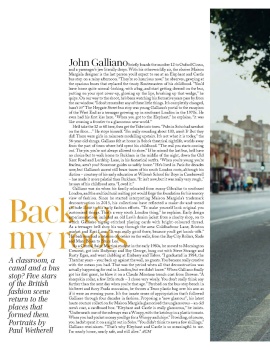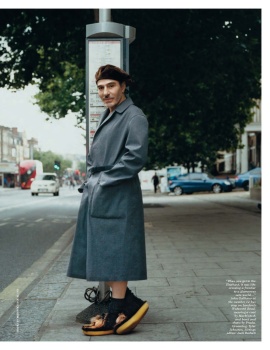Take fashion’s current temperature and you’ll see the relationship between creativity and commerce has never been more fraught. If you’re searching for a middle ground, we suggest heading to Barneys, which has partnered with Maison Margiela for its fall windows. The retailer’s four Madison Avenue–facing vignettes were created as a collaboration between Maison Margiela creative director, John Galliano, and the department store’s creative director, Dennis Freedman, to reflect ideas from Maison Margiela’s Spring 2016 Artisanal and Fall 2016 ready-to-wear collections—namely those of juxtaposition and deconstruction.
The windows are notable not just for their striking visual displays, but also because their immediate message is not necessarily about shopping at all. One of the four scenes features two pieces from the Artisanal collection that aren’t even available to buy inside the store. “It’s the first time since I’ve been at Barneys that we’ve shown couture, in this case the Artisanal collection, because we wanted to make it very clear how John works and how the Artisanal collection really is a laboratory in a way that ultimately informs the ready-to-wear pieces,” said Freedman. Another window features a mannequin in a jacket with a knit muff over its hands, surrounded by golden stalks of wheat from which enormous, to-scale 3-D models of the hands of God and Adam from Michelangelo’s The Creation of Adam emerge. “In its way, it’s telling the story of creation, and what better metaphor for a designer, for a creator?” asked Freedman, making clear that these windows are meant to communicate the depth of Galliano’s rich creativity. Barneys is the broadcaster, with the added bonus that you can buy that shearling jacket inside.
The process of working on the windows began shortly after the Fall 2016 shows in Paris at a meeting in Maison Margiela’s Paris atelier. “You’re walking through this space where the furniture is painted white, employees are wearing lab coats, and then you open the door to John’s studio, and all of a sudden you’re entering into this kind of magical cabinet of curiosity, filled with objects, filled with color, filled with inspiration. John had laid this wonderful table with teapots and tea cakes and pastry, and I kind of felt a little like Alice in Wonderland, coming in and entering the Mad Hatter’s tea party,” Freedman remembers. “It was an environment so inspiring, so rich with imagery, so many things to look at, that it was a physical, visual sensation—even the smell of the tea and the pastry. I knew I’d entered this magical world and I almost felt like I was entering into the creative mind, in some ways, of John Galliano.”
Here, Galliano speaks to the process of collaborating with Barneys and the spirit of Maison Margiela.
The themes of the windows are juxtaposition and deconstruction—how do you take these ideas and translate them into clothing? Do they feel particularly relevant now considering that the way people see fashion today is primarily through the jumble of images that appear on social media feeds?
Maison Margiela was founded on the principles of subverting traditional modes of dress through contemporary interpretations of historical and archetypal garments. These processes have been the house’s modi operandi for many years—with the result that a single garment can reflect different time periods and styles. This remix is particularly relevant now—all creative industries are looking to the collage that is social media, however, for us, the context and provenance of our research still remains crucial. Our dedication to the creative process transcends the garment, celebrating the Maison’s design elements and techniques, where traditional order is disturbed with emotion. Barneys has provided us with a rare opportunity to reveal our world.
I’m fascinated by the range of references used in the windows, from the gesture of Michelangelo’s Sistine Chapel to the idea of pigeonniers. Could you speak about your process of finding references and how you use them in your design process?
Our research process sweeps through different realms (historically and geographically), always starting from our distinct European roots that branch out into a melting pot of global, ethnic references. We collect books and vintage pieces, we travel physically and via the Internet in order to research each collection. We then apply these inspirations to our design process in varying ways: We weave custom fabrics, create handcrafted accessories and textile applications to apply to the silhouettes, and then there is the draping and the shapes themselves. Wherever our inspiration begins it always becomes something else, translated in the Maison Margiela spirit with our trademark trompe l’oeil or “trick of the eye” effect.
History and historical fashion have long been inspirations for you. Could you take us through some of the historical details in these looks?
Some of the pieces echo the concept of collage that began in the Artisanal collection and [continued] in ready-to-wear. The Artisanal outfits framed within the pigeonniers include a trench coat sliced with a pleated evening dress, and a double-breasted man’s blazer from which bomber jacket lining and a pink cloqué jacquard explodes into a gown. You can see how a silver evening dress is draped over the front of a nude slip, or a military aviator jacket becomes a shearling cape.
The contesting ideas of uniformity and uniqueness are present in both the Fall 2016 and Spring 2016 Artisanal collections. Why do these themes feel right for fashion now?
Uniformity and anonymity are keystones of Maison Margiela’s aesthetic and they are the perfect counterbalance to the feeling of individuality we have been exploring of late—that freedom for a woman to dress how she feels, sometimes in the most avant-garde way. It is not our place to say what feels right for fashion in general now—only what is right for Maison Margiela and the people we dress.
Fashion now is more immediate than ever, but your Maison Margiela collections—and the corresponding windows at Barneys—are creations that really warrant taking the time to brood over. Do you feel the pressure of “fast fashion” or do you think the Maison Margiela consumer reacts to something that merits deeper exploration?
Maison Margiela operates against the rules of “fast fashion.” Our designs are a continuing journey that begins at the top of the pyramid with the Artisanal collection and is carried throughout the different lines of the ready-to-wear, shoes, and accessories for women. If anything, “fast fashion” motivates us to explore the possibilities of our ateliers even further, to create designs that exist above and beyond any chance of mimicry.














